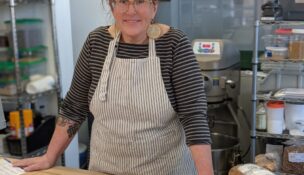CorePower finds the right flow for growth
David Lewis //April 21, 2011//
CorePower Yoga CEO Trevor Tice is on the road again, this time in Berkeley, Calif., celebrating the opening of his company's 50th yoga studio.
Back in Colorado, CFO Linda Schmehl outlines the company's plan to double to 100 yoga studios in four to five years, "a very, very conservative plan in our opinion," she points out.
CorePower Yoga revenue has grown from about $6.5 million in 2007 to $23 million in 2010, with $30 million expected this year. There are about 8,000 U.S. yoga studios, but Denver-based CorePower Yoga is by far the largest corporate chain.
CorePower Yoga, in short, amply earned this year's ACG Emerging Corporate Growth Award, an honor given to companies with annual sales of less than $100 million that have demonstrated steady growth for three consecutive years.
The company's version of yoga – an endeavor with roots in ancient India – is as hot as any brand.
Schmehl calls the CorePower business model "highly successful. Our brand is very relevant and resonant in our demographic, and the uptake on our product when we move into a market is pretty high; it happens pretty quickly."
CorePower Yoga counted about 2 million studio visits last year from about 750,000 individuals, Schmehl estimates.
"We open studios, and within 18 months to two years they are packed, and we can't get another person in them, so then we open another studio," she says. "Actually, there's probably already another studio in the pipeline."
Who are the people flocking through CorePower's doors?
About 80 percent are female, although the numbers of males in the 25- to 35-year-old demographic are rising, Schmehl says.
She describes the CorePower Yoga demographic group as living in a densely urban area, affluent, very fit, and "rather liberal, in that they are open to new ideas."
Actually, she says, in some ways the CorePower Yoga demographic is Trevor Tice.
Tice, a Telluride native and skier, runner, biker and high-tech entrepreneur, founded the business after shattering his ankles in a rock-climbing fall off a cliff onto his feet. One ankle could be repaired; the other required multiple surgeries and required six pins.
Traveling for his second startup, TechPartners International, "I needed a physical outlet to keep in shape," he recalls. "So everywhere I would go – as opposed to going running, which I used to do – I would check out the yoga scene.
"This totally transformed my life and my body," Tice adds. "I got super-attached to it, and would check out these studios. All over the country the customer service was terrible and the teaching was marginal, inconsistent. As a serial entrepreneur in the tech business I thought, ‘Shoot, I can do this better.'"
In 2001, Tice sold TechPartners for $60 million and opened his first yoga studio at 333 E. 13th Ave., a block from the Colorado capitol.
CorePower features a menu of yoga centered on the idea of "vinyasa," or "flow." That means yoga postures flowing one into the other in a heated, mirrored studio with professional instruction, music and lighting, plus locker rooms and showers.
Lest this sound easy, passive or contemplative, it is not.
"People have the misconception this is stretching," says Tice. "It isn't. It's a full-body workout."
Schmehl, a self-described gym rat, used to be put off by yoga's pace. A good stretch, she says, but a bore.
"Our product is highly, highly differentiated from what traditional yoga is," she says. "Our yoga is ‘power vinyasa flow.' Our classes move fairly quickly. They are highly athletic. The environment is heated, so it is very strenuous, which is completely different from what your mom's yoga was. There are some aspects of the spiritual nature of yoga in our offering, but not a lot. It is very attractive and very accessible."
Schmehl explains that in most CorePower classes, "You go in, you do your heated power vinyasa flow, it's very powerful, you sweat your buns off and you're soaked when you get out of there. So it's very attractive."
That's why, in a word, the company's strategy is:
"Expansion," Schmehl says. "Our strategy is to expand into new markets and expand the markets we are in. Right now we are in Denver, Minneapolis, San Diego, Los Angeles, Portland and Chicago. A lot of those markets are really dense populations that can take a lot more growth."
{pagebreak:Page 1}






















